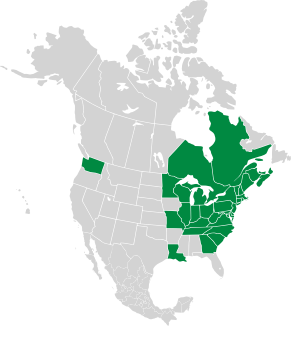Persicaria arifolia (L.) Harolds.
Polygonum arifolium L. var. lentiforme Fernald & Grisc.
Polygonum arifolium L. var. pubescens (Keller) Fernald
Tracaulon arifolium (L.) Raf.

|
Polygonum arifolium L. Halberd-leaved tearthumb
Halberd-leaved tearthumb is a rather strange-sounding name. “Halberd-leaved,” for its leaves’ resemblance to a rather nasty ancient weapon; “tearthumb,” for the backward-pointing barbs on its stems. The plant is native to eastern North America. Plants: This vinelike plant has weak stems that are green, pink or red, with many tiny backward-pointing barbs used to support it as it grows over other plants. Plants may be 2-4′ (60-121 cm) long. Leaves: Shaped like arrowheads, except that the backward-pointing barbs point outward (technically, “hastate”). Leaves are hairy, 4-4½″ (10-11 cm) long. Flowers: Flowerheads are less than ⅜″ (1 cm) in diameter, white to light pink in color. Each rounded flowerhead consists of 5-20 individual flowers at the end of a long stem, which emerges from a leaf node. Fruits: Rounded reddish-brown nutlets about ⅛″ (3.2 mm) around. |
Halberd-leaved tearthumb and its namesake, a halberd from 14th-16th century Sweden. |
||||||||||||||||||||||||||||
|
These similar species are most easily distinguished by leaf shape: | |||||||||||||||||||||||||||||
| You are here Polygonum arifolium |
Polygonum sagittatum |
Polygonum perfoliatum |
|||||||||||||||||||||||||||
|---|---|---|---|---|---|---|---|---|---|---|---|---|---|---|---|---|---|---|---|---|---|---|---|---|---|---|---|---|---|
| Common Name |  |
 |
 |
||||||||||||||||||||||||||
| Plant | Vine has weak stems that are green, pink or red, with many tiny backward-pointing barbs, 2-4′ (60-121 cm) long | Stems 3-6′ (91-182 cm) long, green, pink, or red, hollow, vinelike, with squared edges and tiny, backward-pointing prickles. | Vines have reddish stems with backward-pointing hooks that allow it to clamber over other plants. | ||||||||||||||||||||||||||
| Flowers | Flowerheads are less than ⅜″ (1 cm) in diameter, white to light pink, with 5-20 individual flowers at the end of a long stem | Flowerheads are less than ⅜″ (1 cm) in diameter, white to pink in color. Each rounded flowerhead consists of 5-20 individual flowers at the end of a long stem. | Flowers and fruits emerge from the ocreas. Flowers are white, but inconspicuous. | ||||||||||||||||||||||||||
| Leaves | Leaves are shaped like arrowheads, except that the backward-pointing barbs point outward (technically, "hastate"). Leaves are hairy, 4-4½″ (10-11 cm) long | Shaped like narrow arrowheads, attached via short ⅜″ (1 cm) stems. The base of each leaf tends to wrap around the stem. Leaf edges also have tiny prickles. | Mile-a-minute vine has leaves that are almost perfect triangles, small curved barbs along its stems, and saucer-shaped leaves (ocreas) at its stem nodes. Although ocreas are present in all Polygonums, they usually take the form of a fibrous sheath wrapped tightly around the plant stem. | ||||||||||||||||||||||||||
| Fruit | Seeds are rounded reddish-brown nutlets about ⅛″ (3.2 mm) around | Small nutlets, brown to black. | Tightly packed clusters of 10-30 lobed metallic blue fruits, each about ⅛-¼″ (3.2-6.3 mm) around. Each lobe or segment contains a single glossy, black or reddish black seed. | ||||||||||||||||||||||||||
| Range/ Zones |
|
|
|
||||||||||||||||||||||||||
| Habitats | Marshes, swamps, wet meadows | Wet, marshy ground | Almost anywhere there are warm moist or wet open areas: woods, wetlands, roadsides, fields, stream banks, forest edges. | ||||||||||||||||||||||||||
| Type | Wild | Wild | Wild | ||||||||||||||||||||||||||
| Occurrence | Common | Common | Invasive | ||||||||||||||||||||||||||
Online References:
The Virginia Tech Weed Identification Guide
The Connecticut Botanical Society's Connecticut wildflowers site
The Lady Bird Johnson Wildflower Center
Persicaria arifolia (L.) Harolds.
Polygonum arifolium L. var. lentiforme Fernald & Grisc.
Polygonum arifolium L. var. pubescens (Keller) Fernald
Tracaulon arifolium (L.) Raf.
Polygonum arifolium description by Thomas H. Kent, last updated 6 Sep 2021.
© FloraFinder.org. All rights reserved.
Range:
